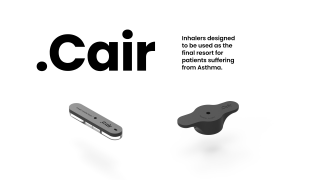- 3750
- 330
- 14
- 11
- 0
- Help Ukraine
About the solution
Interested in the issue of poor patient compliance, Kevin Bui, Justo Caballero, Elvis Ikwa, Allison Mateo, and Shivani Torres became intrigued with the treatment of cystic fibrosis (CF) and decided to further investigate healthcare challenges in this space.
This team began its work by better understanding the patient experience, which meant that they not only researched CF, as a disease but also began to gather all the information they could find regarding patient experiences and struggles. This meant that they became avid readers of patients' blogs, and reviewed journal articles, but also spent as much time as possible talking to patients, doctors, and nurses in the field, most of them at the Stanford Cystic Fibrosis Center.
After taking into consideration all the patient considerations, all 5 students began to see a pattern, where the treatment for CF required patients to clear the airways several times each day, most often through manual chest percussion therapy. This was a very time-intensive regiment, all while being uncomfortable, costly, and often requires going to a care center. This gave rise to one of the biggest problems in CF treatment, which is compliance, where the lack of compliance exacerbates the accumulation of mucus, making the lungs more susceptible to infection, which increases hospitalizations and lowers life expectancy.
The team then envisioned making CF treatment less time-intensive and more user-friendly,especially for those who are active and on the go. They thought about developing a device that was portable, passive, and discreet in order to address the most common concerns affecting patient compliance. This device used small motors placed against the patient’s back that would create a vibrational force that resonated at the frequency of the lung, and would have the same effect as percussive treatment,”.
This small idea inspired the students to adopt the team name “Resonair.”
This culminated in an ordinary-looking backpack fitted with four small, individually adjustable motors, permitting relative comfort as well as portability and discretion. This creative solution to a challenging problem was recognized with a $10,000 third place award at the National Institute of Biomedical Imaging and Bioengineering DEBUT (Design by Biomedical Undergraduate Teams) competition.
The students performed some preliminary efficacy and outcomes testing on the device, but ultimately put the project on hold to pursue other professional endeavors
Adapted from https://biodesign.stanford.edu/our-impact/stories/bioengineering-student...
DISCLAIMER: This story was written by someone who is not the author of the solution, therefore please be advised that, although it was written with the utmost respect for the innovation and the innovator, there can be some incorrect statements. If you find any errors please contact the patient Innovation team via info@patient-innovation.com
This solution shall not include mention to the use of drugs, chemicals or biologicals (including food); invasive devices; offensive, commercial or inherently dangerous content. This solution was not medically validated. Proceed with caution! If you have any doubts, please consult with a health professional.
-
-
270
-
1
-
3327

Scan4myHealth | Real-time solution for monitoring patient vital signs
CAREGIVING
COMMUNICATION: Communicating, whether by speaking, listening, or other means
Stroke
App (Including when connected with wearable)
AI algorithm
Assistive Daily Life Device (to help ADL)
Promoting self-management
To implement medical examination
Restoring heart health
Managing diabetes
Manage Medication
Rehabilitating After Stroke
Preventing (Vaccination, Protection, Falls, Research/Mapping)
Caregiving Support
Cardiology
General and Family Medicine
Internal Medicine
Physical Medicine and Rehabilitation
Pneumology
Portugal
-
-
-
654
-
0
-
9666

Patient develops wearable for Asthma
VENTILATION
CAREGIVING
Asthma
Assistive Daily Life Device (to help ADL)
Treatment/Surgical device
App (Including when connected with wearable)
Pharma
Improving respiratory function
Promoting self-management
Manage Medication
Preserving Organ Function
To implement a diagnostic tool
Alleviating Allergies
To improve Treatment/Therapy
Preventing (Vaccination, Protection, Falls, Research/Mapping)
Caregiving Support
General and Family Medicine
Immuno-allergology
Pneumology
Australia
-
-
-
301
-
0
-
3134

Cair, emergency asthma inhalers
VENTILATION
CAREGIVING
Asthma
3d Printed
Fatigue
Difficulty breathing deeply
Rapid breathing (tachypnea)
Shortness of breath
Improving respiratory function
Enhancing health literacy
Promoting self-management
Preventing (Vaccination, Protection, Falls, Research/Mapping)
Raise awareness
Caregiving Support
General and Family Medicine
Infectious Diseases
Internal Medicine
Pediatrics
Pneumology
India
-
 en
en